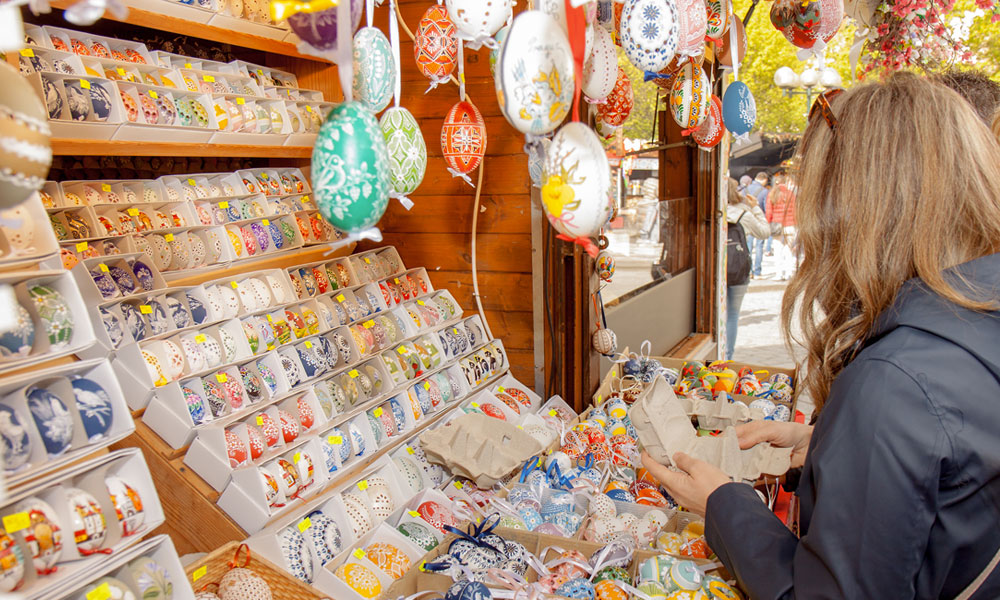Although the Czech Republic is a secular country, traditions related to the Easter holiday are numerous. The earliest Easter celebrations among the Slavic peoples marked the beginning of spring, and only later, they began to be connoted by religious elements. In fact, even before the advent of Christianity, the Easter season was celebrated with great joy and feeling. This festivity was then focused on the awakening of nature and the victory of life forces over winter and death, rather than on the resurrection of Jesus Christ. In those days, the ancients used to collect medicinal herbs with “magical” properties, worship sacred trees and groves believing they were abodes of deities and positive forces, and celebrate the return of the sun during the spring equinox.
Interestingly, although almost 1,200 years have passed since the advent of Christianity in the Czech Republic, most people continue to associate Easter festivities primarily with the celebration of spring. In fact, the traditions observed even today are largely pagan in origin, and the Christian significance often becomes secondary.
Similar to the Christmas season, several days before Easter Sunday, markets begin to proliferate almost everywhere in Prague and stalls selling coloured eggs, along with flowers, flowering shrubs, and cookies.
The Czech term for Easter is Velikonoce, which comes from “velká noc,” meaning “great night,” the day after the night Jesus Christ was resurrected from the dead. Interestingly, while Christmas Eve is considered the most significant date of the Christmas holidays, during the Easter festivities, it is Holy Monday that takes on that role, to the point that Sunday is considered more of a day of preparation for what is to follow.
The week of Easter is referred to as the Holy (or Passion) Week. The day that marks the beginning of that week is the Palm Sunday, which is the Sunday before Easter, but the first significant day is Wednesday, called škaredá středa” (“Bad Wednesday”) or “sazometná středa” (Ash Wednesday). “Bad” as it commemorates the betrayal of Judas.
The Pomlázka
The Angel Monday is marked by a peculiar tradition that is particularly alive in rural areas. On this day, men go to the women carrying the “pomlázka,” a whip made of woven willow branches, with which they symbolically “whip” them. In return, they receive decorated eggs or sweets and a small glass of Silvovice, an alcoholic fruit distillate. This practice has ancient origins and was considered a way of wishing women youth and health throughout the year. Tradition then dictates that, after being used, the pomlázka is planted in the ground so that it can eventually give birth to a new willow tree.
In some regions, it is also still customary to use tree frogs. From Thursday to Saturday, young boys walk around the streets in the village making noise with wooden tree frogs symbolically drawing the faithful to church.
Kraslice: The colourful Easter eggs
The tradition of kraslice (Easter eggs) is deeply rooted in Czech Easter festivities representing an ancient pagan symbol of fertility and life that has now become a jewel of folk art.
Historians trace the custom back 900 years to the 11th century when fragments of an egg painted black were found in southern Moravia. Originally, eggs were coloured red to symbolize life, renewal of energy, new blood, and love. In fact, the colour red is still considered the colour of Easter-one of the most vibrant colours, symbolizing health, joy, and new life coming with spring. Red eggs used to be rolled down the spines of cows in the hope that they would give birth to healthy calves, and they were then dashed against tree roots for good luck.
Today the eggs are decorated with intricate designs and bright colours, often using wax and dye techniques. These decorated eggs are considered a symbol of rebirth and fertility and are exchanged among friends and family as a sign of good luck.
The art of kraslice is so important to Czech culture that a dedicated association, the AMMK, has been created to preserve this tradition. Among the various traditional decoration techniques, we can mention the “vosková batika“, one of the most widespread techniques in Bohemia and Moravia.
The traditional Easter dishes
As in many European countries, it is common in the Czech Republic to enjoy a delicious Easter meal with family during traditional celebrations, and also the Czech Republic has its own typical dishes.
On every Easter table, it is usual to find the sweet lamb, called beránek, a traditional cake symbolizing Christ’s sacrifice. Carefully prepared, this cake takes the form of a lamb with fine details: sultanas are placed in place of eyes and the surface is sprinkled with vanilla sugar or covered with chocolate, creating an image resembling a tender lamb.
You will often find ‘mazanec‘. This typical cake is nothing more than a loaf of leavened dough, similar to “panettone”, enriched with almonds and sultanas, traditionally eaten at breakfast with butter and jam.
In many regions of the Czech Republic, you can also find Easter ‘jidáš‘, namely leavened plaits brushed with honey, the shape of which is reminiscent of the rope with which Judas hanged himself, and “bozi milosti”, a kind of sweetened pancakes made of choux pastry, similar in taste to Spanish churros.
Finally, on Easter Saturday, the day marking the end of Lent, tradition wants that meat stuffed with a mixture of fresh green herbs or young nettles is prepared as a symbol of the awakening of spring and nature.
Jarní Písně
Singing of Easter songs, known as jarní písně, is another popular tradition during Easter week. These songs are often performed by groups of children who go around the houses of the community, singing and receiving eggs or sweets in return.
Sources: https://www.visitczechia.com/, https://www.expats.cz/, https://www.myczechrepublic.com/





